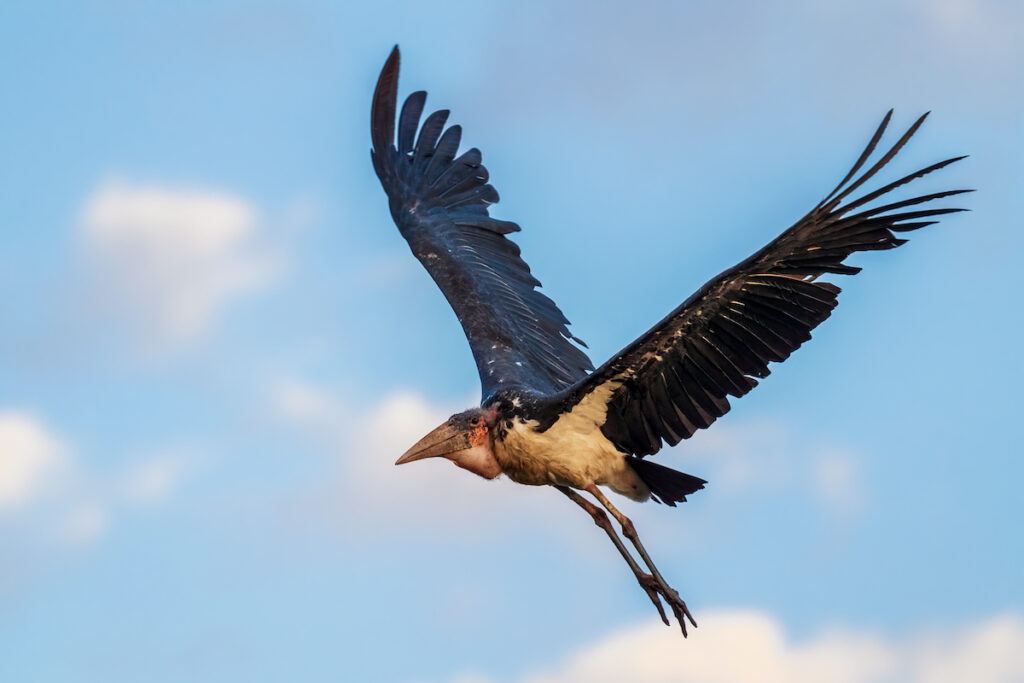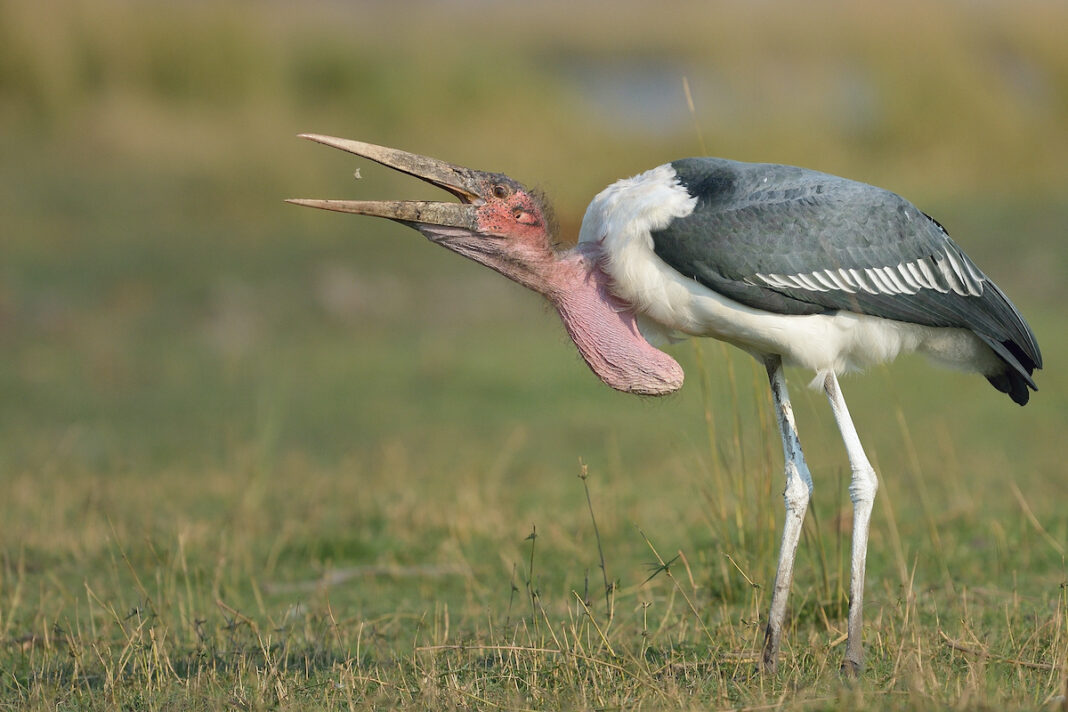Few birds seem to take things as seriously as the marabou stork, yet its life is as colourful as its plumage is sombre. BILL NAYLOR introduces this species and its formidable relatives
THE crowd scenes at waterholes in African wildlife documentaries often feature a group of marabou storks (Leptoptilus crumenifer): huge, bald-headed, long-legged, upright birds with formidable beaks. Their great pink pendulous gular pouch is used to dissipate heat. It resembles either a deflated balloon or, when filled with air, a water bag, and is prominent even on a naked nestling. Marabous’ legs look as though they’re streaked with white chalk, due to their habit of defecating on them to keep cool. Apart from a few wispy feathers on the head, the skull and face (often blue-blotched as though it is bruised) are, like the neck, devoid of plumage.
This species is never chosen for a tropical bird calendar, but is nevertheless impressive. Possessing a 9ft wingspan, it is the largest of storks. (The renowned African ornithologist Richard Meinertzhagen claimed a record for a marabou with a 13ft wingspan. However, this record is suspect since Meinertzhagen is known to have falsified large amounts of data.)
“A stork that behaves like a vulture” is a well-known assessment of the marabou. All storks are carnivorous. Unlike herons and bitterns, which hunt exclusively by sight, storks also use the tactile sensitivity of their beaks, especially in water. There, they forage open-beaked and prey triggers a reflex snapping action, which has a high percentage of success. The marabou is chiefly a carrion eater, though it takes a wide variety of livefood, ranging from termites and locusts to young birds and even fledgling flamingos, occasionally adults. They will land in trees of colony-nesting weavers and eat their fill of nestlings.
When in vulture mode, the marabou glides high over the terrain, its broad wings assisted by thermals. Wanderers have been recorded as far from their usual range as Spain. Unlike other storks, which fly with neck extended, a marabou’s is withdrawn, the legs held slightly downwards as it scouts for mammalian predators or groups of vultures feeding on prey. When it arrives at a kill, it commands respect, standing from 3ft to 5ft high, with a sword-like bill which continues to grow till it is 35cm long (more than 12in!) Assemblies of marabous alongside carcases have earned the name “undertaker bird”. As with all local superstitions about storks, they are seen as pest controllers and some even deliver the occasional infant. Despite this benevolence, their habitat is much reduced because of the draining of wetlands and urbanisation.

Vulture-like: a marabou shows off its 9ft (not 13ft) wingspan © Shutterstock.com/David Havel
Sombre but sociable
Marabous are opportunists, and early game-hunters write of how they would loiter near camps. Increasingly now they frequent fishing villages, rubbish dumps and slaughterhouses. They always seem in a sombre mood. “That’s as happy as they get,” was how one head birdkeeper described a pair of marabou in his care. “Philosopher bird” is another name, referring to their (presumed) inner contentment. The name “marabou” comes from the Arabic murabit meaning “Muslim holy man” or “hermit”. But this is no solitary bird. A colony breeder, it also roosts communally. Periodically marabous will disappear from a location for months before returning. They can be found in wetlands and savannahs where they will forage among antelope and other grazing mammals, feeding on the animal life they disturb. They are absent from true desert and forests.
Despite being sociable, they can be disagreeable and aggressive towards their colleagues in the wild and in captivity. Because of those impressive – if daunting – looks, they are commonly kept in mixed exhibits, sometimes with other birds, antelope or cattle. Nonetheless, aggression is an unresolved issue with captive birds. According to the International Zoo Year Book (Vol: 33. 2007), in 2006 and 2007, 32 per cent of marabou deaths in European zoos were due to aggression. (Females are as belligerent as males.) During the same period, 16 per cent of marabous died after skirmishes with hoofed stock sharing their enclosures.
Like most storks, male marabous tend to be larger than females. Although this is not always obvious, it may be seen from when they are youngsters in the nest. Other sexual differences are usually absent in storks. They are only notable in the saddlebill (Ephippiorhynchus senegalensis) and jabiru (Jabiru mycteria), in which the male’s pupils are brown and the female’s golden yellow.
The marabou shares its genus with two closely related and similar species which are also carrion eaters. The lesser adjutant (Leptoptilos javanicus) and the Indian counterpart of the marabou, the endangered greater adjutant (L. dubius) both derive their name from strutting aloof colonial British military officers. The greater adjutant and marabou are very similar, apart from the marabou having dark eyes, and were once believed to be conspecific.
Like other storks, marabous are largely silent, apart from an occasional grunting. Communication consists mainly of bill-clattering to greet each other and tame storks use the same ritual with humans. It is also employed as a threat or alarm signal. During the breeding season, however, they are more vocal and in breeding colonies there is a constant chorus of squabbles, grunts and groans, which can be heard from some distance.
Despite being numerous and occurring in large conspicuous groups, marabous have suffered little from human persecution. An exception was during the plume trade when they were killed for their soft white downy undertail coverts and the ruff around the neck. Known as “marabou down”, these were used as a popular fur substitute for coat trimmings, “feather” boas and fishing lures. Turkey down was subsequently found to be a cheaper alternative and hunting marabou became no longer viable.
Marabou relations
The greater adjutant, nicknamed “the bone swallower”, was notorious for feeding on dead livestock and human remains in Asian cities such as Calcutta. Since sanitation has improved and it is no longer welcomed as a street cleaner, its distribution is restricted to Assam in north-east India and its population numbers less than 1,200. Captive breeding seems its only hope, although to my knowledge it has not yet been captive bred. Out of the 20 species of storks, at least 15 have been bred in captivity, but the three carrion-eating Leptoptilus storks have proved difficult. The lesser adjutant was bred as Bronx Zoo in 2003.
Marabous are commonly exhibited in zoos. Currently, 31 European zoos house 125 individuals, and zoos in the USA, Asia, Indonesia, Russia and the Middle East also stock them. Yet they have rarely bred: between 1978 and 2002, out of 25 US zoos holding marabous, only eight managed to breed them. Unfortunately, it was once customary to clip or pinion one wing of large captive birds. Pinioned large birds cannot express their full behaviour and in the case of the marabou it inhibits the male from confidently mounting the female. Aware of this disability, males often do not attempt mating.
The first UK breeding of the marabou was at Blackbrook Zoological Park (Staffordshire) in 1999, as documented in the Avicultural Magazine, vol: 106. No 4. (2000)). Two chicks were hatched in an incubator after 32 days and then hand-reared. The second UK breeding – with young being parent-reared – occurred at Paignton Zoo in 2011 (Avicultural Magazine, vol: 118. (2012)). Marabous become sexually mature at four years old. In the wild, they will nest in trees 10-30m off the ground, on cliffs or on buildings. Their colonies sometimes include a mix of other stork species and nesting pelicans. In the past there have been enormous colonies consisting of thousands of birds.
Breeding is dependent on food availability, since a colony requires tonnes of food daily. Only about 20 per cent of adults breed in any given year and pairs do not breed every year. The male builds a nest a metre wide, lined with leaves and defends it aggressively against neighbouring marabous. In the act of courtship he will present sticks to the female, a common ritual among storks. The two or three eggs are incubated for 30 days by both parents.
Young marabous are more drab than their parents, with shorter beaks, and they are unable to stand till they are two weeks old. The breeding of lesser adjutants at the Bronx Zoo revealed that they require three times as much calcium as other comparable nestlings. A good proportion of the mineral is required for the beak and legs to grow properly.
Marabous can live for 20 years in the wild and double that in captivity. One zoo bird was still alive at the age of 48.
Bill Naylor has first-hand experience of numerous bird species from his career as a professional birdkeeper.
Find more news and articles like this on the Cage & Aviary Birds website. Subscribe to Cage & Aviary Birds magazine now.


